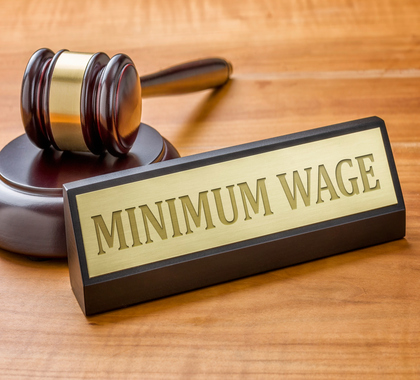This week, the Montana House Business and Labor Committee conducted a hearing on House Bill 484, legislation that would raise the minimum wage in Montana from $10.55 per hour to $12.06 per hour with a cost-of-living adjustment conducted annually based on consumer price index (CPI) data.
It is not uncommon for some state lawmakers to advocate for quick “fixes” in response to perilous economic situations, such as minimum wage hikes. However, minimum wage increases in any state typically negatively impact businesses and individuals. Lawmakers in The Treasure State would benefit from considering all of the effects associated with such hikes.
A paramount concern surrounding increases in the minimum wage is the overall effect upon employment levels. Minimum wage hikes produce unintended consequences that often inflict even more pain upon the very people they are supposed to benefit. Though well-intentioned, minimum wage hikes are a substantial reason for the utilization of self-checkout kiosks by grocery chains and fast-food restaurants, which disproportionately eliminate jobs for vulnerable and low-income individuals.
A 2017 paper from the National Bureau of Economic Research (NBER) studies the effects of the aforementioned scenario, utilizing data collected from 1980 to 2015. The authors conclude that “increasing the minimum wage decreases significantly the share of automatable employment held by low-skilled workers… Our work suggests that sharp minimum wage increases in the United States in coming years will shape the types of jobs held by low-skilled workers, and create employment challenges for some of them.”
Corroborating this argument, a new study released by the Berkeley Research Group (BRG) proves that California’s $20 per hour minimum wage for fast food workers has led to job losses, higher food prices, and increased automation in the industry.
The BRG study found that California’s fast-food restaurants lost 10,700 jobs between June 2023 and June 2024, making it the worst-performing year outside of a recession and the coronavirus pandemic. Additionally, food prices at local restaurants have increased by 14.5 percent, nearly double the national average, since AB 1228—the legislation mandating this wage increase—went into effect.
Further, a study by the Congressional Budget Office (CBO) examines how increasing the federal minimum wage to $15 per hour in 2025 would adversely affect employment and household incomes. While the study does find that a minimum wage increase boosts some workers’ wages, it also leads to job loss for many others, with small businesses often bearing the brunt of economic pain.
A minimum wage increase in Montana would force small businesses to reallocate their costs to cover the increase in employees’ wages, ultimately forcing them to alter spending elsewhere to offset their newly increased labor costs. More times than not, this results in reduced hiring, a reduction in work hours, and increased prices for consumers. This is often the small margin between staying open and bankruptcy for small businesses, which typically operate on slim margins, to begin with.
In fact, a recent report from the Employment Policies Institute (EPI) found that a minimum wage hike would cost the U.S. economy approximately two million jobs. The EPI study notes that of those two million jobs, those most likely to vanish are in the restaurant and hospitality industries already steamrolled by the COVID-19 pandemic. Forcing small businesses in these industries to raise their labor costs would inflict even more harm upon the few that have managed to survive.
The country’s continued macroeconomic vulnerability is also important to consider. While unemployment rates have improved since their pandemic lows, the labor force participation rate has not rebounded in the same way. According to the U.S. Bureau of Labor Statistics, there were 7.6 million unfilled jobs on the last business day of December, according to their early February 2025 Economic News Release.
As for inflation, the January 2025 Consumer Price Index (CPI) report exposed that over the last 12 months, the all-items index increased 3.0 percent before seasonal adjustments.
Price increases in shelter, medical expenses, energy, gasoline, and food are felt by all Americans, with Montana being no exception. According to World Population Review, the average monthly cost of groceries per person in Montana was $323.91 in 2024.
Given the ongoing economic disorder, it is unsurprising that lawmakers may be turning to minimum wage to provide relief to their struggling constituents. Yet, these efforts are both ineffective and counterproductive ways of combating the problem, as they will drive up the costs of goods and services while putting many out of a job altogether.
Although attempts to bolster a minimum standard of living and protect wage workers are laudable, the overall economic effects of forced minimum wage hikes accomplish neither of those worthy goals. Arbitrary minimum wage hikes, out of sync with the laws of supply and demand, would do little to lift struggling individuals and families in Montana from poverty while destroying jobs and likely increasing government dependence. Because of this, it is crucial for lawmakers in The Treasure State to consider all of the effects of minimum wage hikes as they move through the legislative session.
The following documents provide more information about minimum wage laws.
Busting 5 Myths About the Minimum Wage
http://blog.heritage.org/2013/03/05/busting-5-myths-about-the-minimum-wage/
James Sherk of The Heritage Foundation debunks five myths about minimum wage hikes, often used by proponents of minimum wage laws: “A higher minimum wage would help some workers, but few of them are poor. The larger effect is hurting the ability of potential workers living in poverty to get their foot in the door of employment. A minimum wage hike might help politicians win plaudits from the press, but it wouldn’t reduce poverty rates.”
Unintended Consequences of Raising the Minimum Wage
http://mercatus.org/publication/unintended-consequences-raising-minimum-wage
Antony Davies of the Mercatus Center examines arguments for and against minimum-wage increases and presents new results comparing employment for workers with differing educational attainments.
The Negative Effects of Minimum Wage Laws
Mark Wilson of the Cato Institute reviews the economic models used to understand minimum wage laws and examines available empirical evidence. Wilson describes how most of the academic evidence shows minimum wage laws have negative effects, and he discusses why some studies produced seemingly positive results.
The Effects on Employment and Family Income of Increasing the Federal Minimum Wage
The Congressional Budget Office examines how increasing the federal minimum wage to $10, $12, or $15 per hour by 2025 would affect employment and family income across the nation. This shows that while minimum wage increases will provide some level of raised wages for some individuals, it will also lead to many workers across the nation losing their jobs.
Two-thirds of Americans Favor Raising the Federal Minimum Wage to $15 an Hour
The Pew Research Center conducted a survey in the spring of 2020 regarding the public approval of raising the federal minimum wage to $15 an hour. This shows the overwhelming trend of many across the nation believing that minimum wage increases are a viable way to pull Americans out of poverty.
___________
Nothing in this Research & Commentary is intended to influence the passage of legislation, and it does not necessarily represent the views of The Heartland Institute. For further information on this and other topics, visit the Budget & Tax News website, The Heartland Institute’s website, and PolicyBot, Heartland’s free online research database.
The Heartland Institute can send an expert to your state to testify or brief your caucus; host an event in your state; or send you further information on a topic. Please don’t hesitate to contact us if we can be of assistance! If you have any questions or comments, contact Heartland’s Government Relations department, at [email protected] or 312/377-4000




